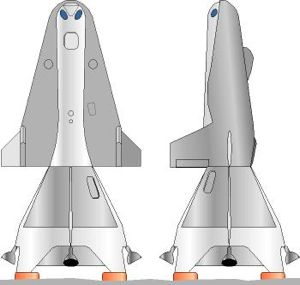
Home - Search - Browse - Alphabetic Index: 0- 1- 2- 3- 4- 5- 6- 7- 8- 9
A- B- C- D- E- F- G- H- I- J- K- L- M- N- O- P- Q- R- S- T- U- V- W- X- Y- Z
Lunex Lunar Lander
 Lunex Spacecraft Credit: © Mark Wade |
Status: Study 1958. Gross mass: 61,000 kg (134,000 lb). Height: 16.16 m (53.01 ft). Span: 7.62 m (24.99 ft).
This payload would consist of a Lunar Landing Stage, Lunar Launch Stage and a 3-man Lunex Re-entry Vehicle.
This payload was 16.1 m long, and the interface diameter with the Space Launching System was 7.62 m. The complete payload weighed 61,000 kg at escape velocity, and a 9,163 kg Manned Re-entry Vehicle was returned to the earth.
The Lunex Re-entry Vehicle had to be capable of entering the earth's atmosphere with a velocity of approximately 11.3 km/sec. At that time, basic re-entry information for velocities of this magnitude did not exist. Therefore, engineering design effort for this re-entry vehicle would have to be accomplished concurrently with other major sub-systems developments and integrated with the High-Speed Re-entry test program and the Abort System test and development program.
Another major problem facing the re-entry vehicle development program was the life support package. The planned schedule required the manned life support package to be designed on the basis of earlier primate shots, Mercury shots and the Discoverer series.
The Lunar Landing Stage had to be capable of landing the Lunar Launching Stage and the Lunex Re-entry Vehicle on the lunar surface. This was considered a difficult design problem because little was known about the lunar surface. The only practical design approach was to provide an alighting system capable of landing on an extremely rough surface. An automatic leveling, orientation and launching system was required for system check-out prior to manned flight. Therefore, any assumption that the Manned Lunar Payload could be moved about on the lunar surface or that the payloads might initially transfer fuel on the lunar surface, could be entirely erroneous and jeopardize the complete Lunar Expedition effort. The landing stage would also have to be developed so that it was capable of landing the Cargo Payloads on the lunar surface.
The Lunar Launching Stage had to be developed with a different philosophy than the previous sub-systems. First, it only operated in the vacuum of space and on the lunar surface. Secondly, it would be required to function after it had been located on the lunar surface for an extended period varying from several days to many months. Therefore, the stage had to be developed to launch the re-entry vehicle after being subjected to a better vacuum then available in our best earth laboratory facilities, following possible temperature variations of 400 to 500 degrees, following possible meteorite bombardment and from a less than optimum launch angle. Specifically the stage development had to consider propellant boil-off, automatic check-out, self-erection and remote (earth-moon) launching procedures.
The Lunar Launching Stage represented the major reliability problem of the system because an abort capability was planned for every phase of the Lunex mission except during launch from the lunar surface. This created the requirement to develop an extremely reliable Lunar Launching Stage.
The successful support of the Lunar Expedition required a capability to deliver relatively large Cargo Packages to the lunar surface. These Cargo Packages would be soft landed at the desired lunar sites by the Lunar Landing Stage. Each Cargo Package would weigh approximately 20,500 kg and be specifically designed to carry the items desired to support the expedition.
Crew Size: 3.
Family: Lunar Landers, Moon. Country: USA. Spacecraft: Lunex. Agency: USAF.
Back to top of page
Home - Search - Browse - Alphabetic Index: 0- 1- 2- 3- 4- 5- 6- 7- 8- 9
A- B- C- D- E- F- G- H- I- J- K- L- M- N- O- P- Q- R- S- T- U- V- W- X- Y- Z
© 1997-2019 Mark Wade - Contact
© / Conditions for Use